Well, I'm no photography expert and I have compiled this list after going through different websites (kodak.com, wikipedia.org et al). During my early days I used to be excited to find out and learn about different terms like Aperture, silhouette etc. So I thought of listing out the very basic terms in photography that anyone interested(or not) ought to know.
Hope you find this useful. Have fun photographing!
Aperture
Lens opening. The opening in a camera lens through which light passes to expose the film. The size of aperture is either fixed or adjustable. Aperture size is usually calibrated in f-numbers-the larger the number, the smaller the lens opening. The aperture value is responsible for the depth of field in an image. The image below was taken with an aperture of f4.
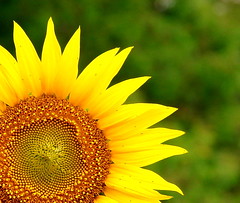
Bokeh
A term derived from the Japanese word for "fool" which when applied to a lens refers to the pleasing quality of the out of focus areas of an image produced by the lens. Below is an image with a pleasant bokeh.
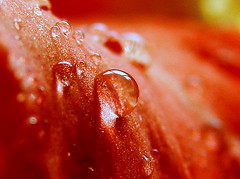
Composition
The pleasing arrangement of the elements within a scene-the main subject, the foreground and background, and supporting subjects. When composed properly, the interestingness of an image drastically inclines.


Cropping
Cropping is the process of selecting and removing a portion of an image to create focus or strengthen its composition. May also refer to the framing of the scene in the viewfinder. Below is an example of how cropping can make a photo more pleasing.

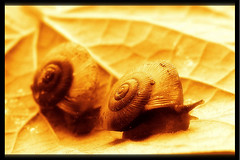
Depth of Field (DOF)
The amount of distance between the nearest and farthest objects that appear in acceptably sharp focus in a photograph. DOF depends on the lens opening, the focal length of the lens, and the distance from the lens to the subject. (photo: wikipedia.org)

Focal Length
The distance between the film and the optical center of the lens when the lens is focused on infinity. The focal length of the lens on most adjustable cameras is marked in millimetres on the lens mount.
ISO Speed
The emulsion speed (sensitivity) of the film as determined by the standards of the International Standards Organization. In these standards, both arithmetic (ASA) and logarithmic (DIN) speed values are expressed in a single ISO term. For example, a film with a speed of ISO 100/21° would have a speed of ASA 100 or 21 DIN.
Macro
Macro photography refers to close-up photography; the classical definition that the image projected on the "film plane" (i.e film or a digital sensor) is close to the same size as the subject. A macro photograph:

Panning
Moving the camera so that the image of a moving object remains in the same relative position in the viewfinder as you take a picture. Example of a panning technique: (photo: wikipedia.org)

Saturation
An attribute of perceived color, or the percentage of hue in a color. Saturated colors are called vivid, strong, or deep. Desaturated colors are called dull, weak, or washed out. See cropping above for examples of saturated and desaturated images.
Silhouette
A silhouette is a view of some object or scene consisting of the outline and a featureless interior. Silhouette is a form of art which can result in some very pleasing photographs. Below are silhouettes of temples in Kathmandu city on a lovely evening.
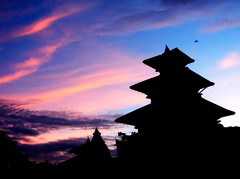
Time Exposure
A comparatively long exposure made in seconds or minutes. This is also known as long exposure. Long exposures can often create very dramatic effects in photography. Use a longer than normal exposure to create the impact of your image.
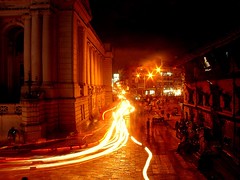
Wide-Angle Lens
A lens that has a shorter focal length and a wider field of view (includes more subject area) than a normal lens. A wide-angle lens takes in a greater angle of view than a normal lens. This image was made with an ultra-wide 16 mm fisheye lens. Notice the curved horizon.(photo: kodak.com)
